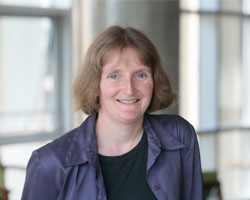Q&A with Julie Arendt: Part of the STEM community

Julie Arendt is part of a three-member team of science and engineering librarians at Cabell Library  whose jobs focus on the needs of science and engineering departments. Arendt’s specific focus is outreach, instruction and research support for engineering and physical sciences. This brief Q&A profile is the third in a series that previously highlighted Erin Carrillo and Ibironke Lawal.
whose jobs focus on the needs of science and engineering departments. Arendt’s specific focus is outreach, instruction and research support for engineering and physical sciences. This brief Q&A profile is the third in a series that previously highlighted Erin Carrillo and Ibironke Lawal.
What are your goals for the 2019-20 academic year?
I have a pretty good groove going with classes I go to regularly for guest lectures and other presentations. At this point, I have a bit more time freed up, so I’m not creating course sessions from scratch. My goal this year is to refine at least some of them to include more active learning and to do more during class time to find out from students what they know and don’t know.
My other plan for that additional time is to spend more time at my departments, for example, at seminars and events. Although I’ve made an effort to meet people, the next step is to get to know them well enough that they’ll think of me as someone to ask for things. One of the sayings in public library circles that I think applies just as much in academic libraries is that people will ask for information from people they feel are part of their community, so it’s a librarian’s job to become part of the community.
Please share any observations you have about the unique nature of the programs you serve and any unique challenges they present you as a librarian.
Science and engineering have a lot more of their information available online than arts and humanities. While this has eliminated some of the challenges of finding and accessing information, it has its own challenges. These include:
- Too Much Not Quite Relevant Information: For example, a researcher builds a mathematical model of a system and needs numbers — either to insert in the model or to test whether the output of the model matches reality. A search in a database for articles that might contain those numbers can yield many results, but very few of them contain the specific information that is sought. Sometimes I can work my librarian magic to find a property database or handbook that has the numbers compiled, but sometimes, it’s a lot of tracing back through reference lists of “almost useful” results to find the precise information needed.
- Library Invisibility: I sometimes meet faculty or students who hardly ever or never visit the library physically and who misperceive that they don’t use it at all. After talking with them for a while, I discover that they regularly use Google Scholar and don’t realize that library staff do things behind the scenes to make opening articles they find in Google Scholar just a matter of clicking on a link. Sometimes this lack of exposure also means they are unaware of the other things the library can do — from interlibrary loan for when clicking on the link in Google Scholar doesn’t work to support for open access publishing to data management assistance to low-barrier access to craft supplies and 3D printing for rapid prototyping. I feel bad that start talking like an infomercial narrator with them, but I also feel bad that they hadn’t heard about it already and have been missing out.
- Tracking and Quantification: At the same time I’m telling Ph.D. students, especially students with common names or students with name changes, that they need to get an ORCID and to connect all of their publications to their online profiles, so they get credit for their work, I’m concerned about the scholar measurement apparatus that’s being built. The tools are available now to track researchers by how often their publications have been cited, by how many patents they hold, and by how much grant funding they received. While that’s a huge improvement over judging researchers by the Journal Impact Factor of where they published, it still focuses on relatively short-term outcomes that are easy to measure and ignores other kinds of research success such as whether graduate students are emerging as successful researchers, how well inventions meet important needs, and how well applied research addresses pressing societal problems.
What are the most common questions or problem areas researchers bring to you?
- Engineering undergraduates often need specific information that they can apply to a design problem they’re trying to solve. They also have questions about locating patents related to their design and about patentability — some of which I can answer, and some of which they would have to research themselves or find a lawyer.
- Faculty and graduate students sometimes send me questions about how to get exactly the piece of information they need, without having to wade through a sea of irrelevant results. Sometimes I’m able to “magically” solve that problem by finding a reference book with the specific number they’re looking for, but often I can only cut back on the irrelevant results
- In teaching, the questions vary a lot depending on the subject or class, but properly citing sources and avoiding plagiarism comes up across every subject area I work with.
What else should VCU science and engineering faculty know about you?
- VCU Libraries are very open to trying new ideas. If you are interested in collaborating on something, don’t be shy about contacting me. I’m at [email protected] and (804) 828-1539.